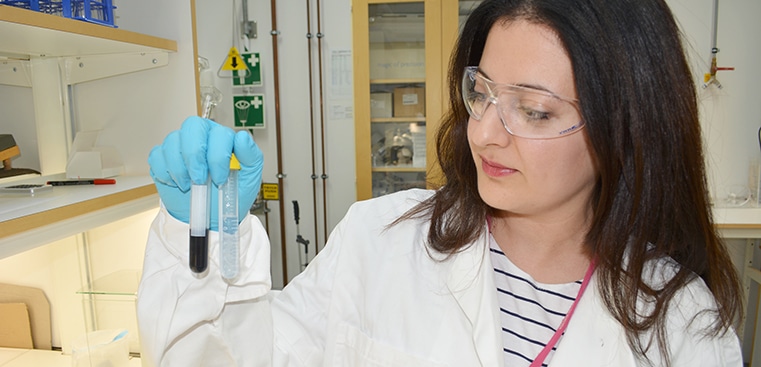Oct 23 2019
Textile dyeing has a significant negative effect on the environment. A study at the University of Borås has currently devloped a new method to degrade the dyes and remove contaminants from the wastewater.
 May Kahoush demonstrates how water has been purified from dyes with the new method. (Image credit: University of Borås)
May Kahoush demonstrates how water has been purified from dyes with the new method. (Image credit: University of Borås)
Almost all efficient processes in the textile industry consume more energy, water, and chemicals for dyeing textiles, which is an ongoing issue. To address this issue, enzymes were employed to induce a degradation mechanism for dyes and other chemicals. This was achieved by ensuring the enzymes are attached to the surface of a support material so that they can function to a greater degree.
Generally, the degradation process is carried out in oxidizing solutions or acids at an elevated temperature and for a longer duration by using traditional methods. This implies that more energy and water are used up during the complete dyeing process, resulting in the discharge of more harmful substances into the environment.
Eco-Friendly Methods
As part of her research work, May Kahoush, a doctoral student, has paid attention to methods that can help purify the wastewater in an eco-friendly way.
In the dyeing process, the excess dyes and chemicals are flushed out with the waste water, which causes great damage to the environment. My goal is to develop an eco-friendly method of purifying the waste water before it is emitted.
May Kahoush, Doctoral Student, University of Borås
She has studied three different methods. All these methods can help find a solution advantageous to the textile industry and the environment by reducing the use of energy and water, as well as the release of harmful chemicals. The difficult task is to find ways to bind the enzymes to an appropriate material.
Attaching Enzymes on Carbon Fiber Textiles
We have used felted carbon fibre textiles, a common material used in many different applications, and using these textiles the enzymes can attach and help degrade the dye molecules. The carbon fibre textile is a porous lightweight material, that resists corrosion and that is easily formed, which can be used as an alternative to expensive, rigid metals.
May Kahoush, University of Borås
Kahoush continued, “The carbon fibre also has good electrically-conductive properties, which is a prerequisite for getting the desired properties in electro-chemical applications.”
However, the difficulty is that the carbon fiber textile remains water repellent. In such a case, she required a water-absorbing material that could essentially allow the enzymes to bind to it. Therefore, the material has to be pre-treated.
Reduced Use of Water, Energy, and Chemicals
In the first method, she used an environment-friendly substance from the gardenia flower to facilitate the enzymes to bind directly to the carbon fiber material surface. In the second method, she used an environment-friendly coating to facilitate attachment of the enzymes.
Finally, in the third method, she performed a cold plasma treatment. Of the three methods, the first two required only little water; by contrast, in the plasma method, there was no need for water or chemicals and required low energy.
The hydrogen peroxide that is produced because of the enzymatic reaction of the enzymes on the carbon fiber material helps to deteriorate the dyes used in textile dyeing. This leads to a reduction in the amount of the dyes and other contaminants that are released.
Methods with Many Advantages
The methods for immobilizing the enzymes offer many benefits, for example, these provide a stable mechanism and facilitate reuse of the enzymes. If enzymes had circulated freely instead, it would have been dangerous as residues of the enzymes might remain on the dyed textiles, leading to allergies and other undesirable effects.
Besides water purification, the method is also used to detect substances to which the enzyme being discussed reacts; here, it is glucose. There is a possibility of producing electricity from biological substances that can generate alcohol or sugar.